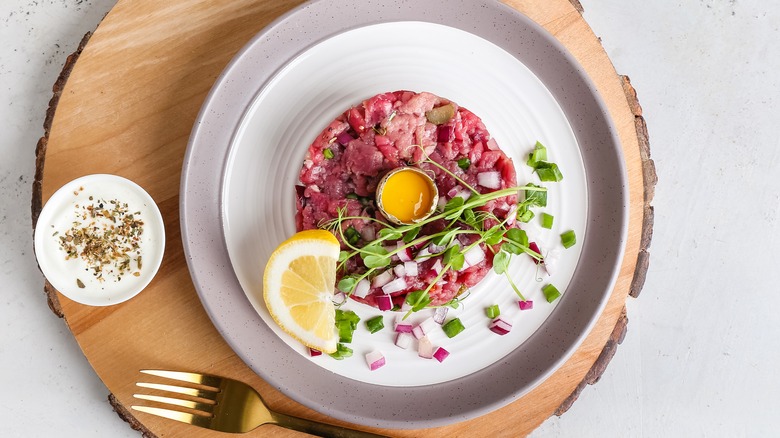Why You Should Freeze Beef Before Making Steak Tartare
Ordering steak tartare at a restaurant doesn't seem nearly as nerve-inducing as preparing the dish at home. Despite any concerns over working with raw meat, the truth is that crafting an elegant tartare is pretty simple. In fact, by following a few tips and tricks like freezing the beef beforehand, you're pretty much geared for success.
Read through any recipe for steak tartare on the internet or in the pages of your favorite cookbooks and you'll likely come across these vital instructions: Chill the beef. The reason why this step is a must, is simple. Placing a filet somewhere cold like the freezer helps the meat become firmer, making it significantly easier to work with. Whether the filet is hand-minced or placed through a grinder, a colder and stiffer cut will maintain its shape better. Plus, since the meat is less likely to become smeared into a paste that's reminiscent of raw hamburger, chilled beef also makes for a more aesthetic tartare.
If that weren't enough, freezing even comes with a safety benefit. While there are always risks involved with consuming raw meat, Food Safety News reports that placing steak in the freezer can prevent the growth of certain bacteria that are responsible for causing illness. As a result, there's no reason why you should ever forgo freezing.
Keeping it cool pays off
After selecting the freshest and most tender filet possible — we recommend the tenderloin — it's time to give the steak a chill. Start by removing the filet from any butcher paper, and place it into a freezer-safe container before moving it to the freezer. Although meat can firm up somewhat in as little as 15 minutes, you'll get better results if you leave it in there for about an hour or two. Just don't go beyond four hours, or you'll be left with an icy block.
Remember that even though the beef is now very cold, it will start to thaw and soften once it's pulled from the freezer. For this very reason, we suggest also chilling the tools you'll be working with. These include sharpened knifes, cutting boards, mixing bowls, and even serving plates. In addition to ensuring effortless mincing, keeping things cool will save you from serving a warm tartare. Yet, while working with cold equipment is important, that doesn't mean your flavorful mix-ins should also be frozen. Chilled additions are ideal, but as long as you don't use piping hot ingredients, they can be incorporated without ridding chilled steak of its freshness.
With the secrets to crafting a perfectly chilled tartare in your bag of culinary tricks, you can finally turn your attention to serving. A side of delicate greens, thinly sliced crostini, or crunchy kettle chips can all complement a made-to-order tartare. Lastly, don't forget to pour yourself a glass of wine.

